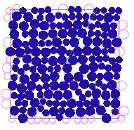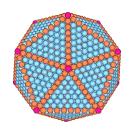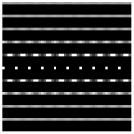Theoretical Statistical and Condensed Matter Physics
Research
 |
The jamming transition in granular materials In granular materials, increasing the volume density of particles ρ above a critical ρc results in a jamming transition between a flowing liquid and a rigid but disordered solid state. It has been conjected that this jamming transition is a special critical point in a broader phase diagram that includes the thermally driven structural glass transition, and the transition between elastic and flowing states in shear driven foams. We have investigated this problem using simulations of soft core disks in two dimensions, finding results that are consistent with this conjecture. Click here for further details. |
 |
Structrual stability of gold nanoclusters In gold clusters consisting of tens to thousands of atoms, surface and bulk free energies become comparable, an effect that plays a crucial role in the determining the shape and structure of such nanoclusters, and their stability against thermal fluctuations. Using the phenomenological "glue" potential to model the many-body interactions between gold atoms, we have used molecular dynamic simulations to study the structure and stability of gold nanoclusters under a variety of conditions. Click here for further details. |
| Vortex fluctuations in type-II superconductors The fluctuations of magnetic field induced vorticies play a crucial role in determining the phenomenological behavior of extreme type-II superconductors, such as the “high-Tc” copper oxide materials, and superconducting networks. Using large scale numerical simulaitons, we map out the phase diagram and study the phase transitions between states of different vortex ordering, both in equilibrium and in driven non-equilibrium steady states, for type-II superconductors in the presence of quenched random impurities. Click here for further details. |
|
 |
Lattice gas methods for driven non-equilibrium steady states By considering the example of a vortex lattice on a discrete two dimensional grid, we show that differnt choices for the microscopic lattice gas dynamics can result in qualitatively different driven steady states far from equlibrium. A commonly used Driven Diffusive Metropolis Monte Carlo method results in an unphysical disordering of the vortex lattice when it depins. A new Continuous Time Driven Diffusive Monte Carlo produces a moving smectic state. Our results illustrate the difficulties associated with using lattice gas models to describe driven steady states when a non-uniform spatial structure is present. Click here for further details. |